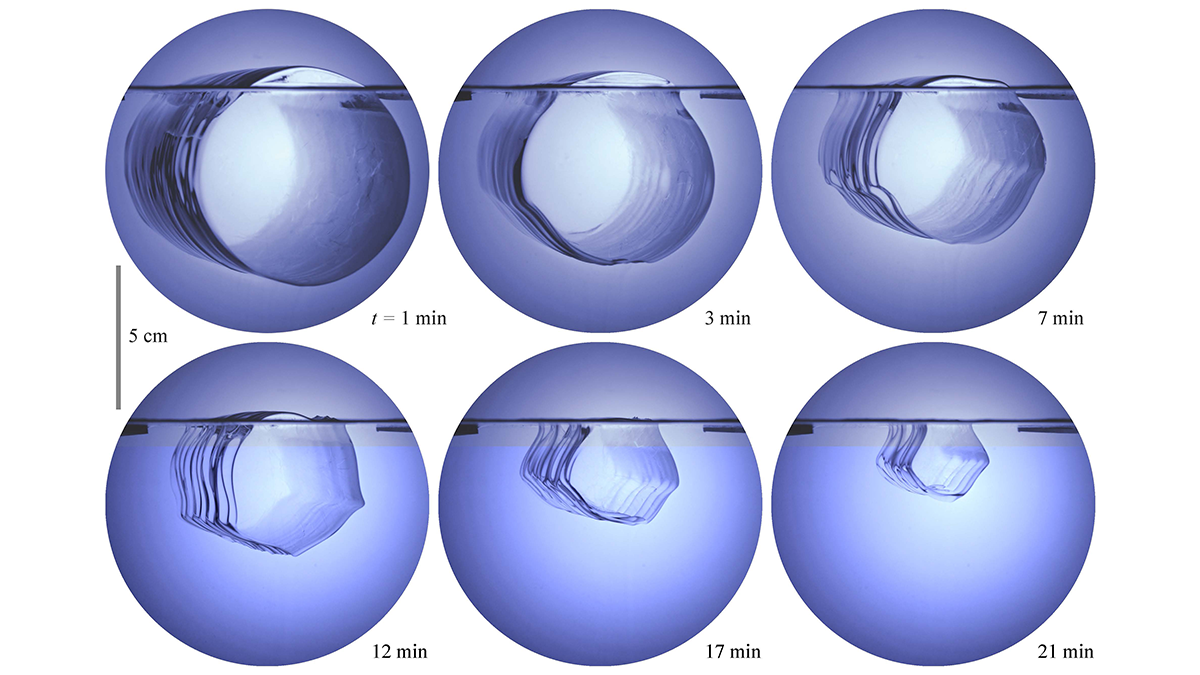The titanic dangers icebergs pose to ships are well documented. Sometimes, however, icebergs themselves can capsize, creating earthquakes and tsunamis or even pushing entire glaciers backward. Most of those dramatic events occur right after the chunk of floating ice splits off from its source, but sometimes icebergs flip over in the open ocean.
Earlier lab experiments using simulated plastic icebergs showed that the energy released in capsize events can rival nuclear weapon blasts. But beyond an understanding that capsize events are likely related to melting induced by ocean warming, knowing why icebergs flip is a question that’s harder to answer. Large variations in iceberg size and shape, along with slow drifting across wide distances, make studying icebergs expensive and challenging.
One solution: make miniature icebergs in the lab and watch them melt under controlled conditions.
“Understanding the mathematics and the physics of what’s going on at a base level is important in order to scale up.”
“We wanted to study the simplest capsize problem we could come up with,” said Bobae Johnson, a physicist and Ph.D. student at the Courant Institute at New York University. She and her colleagues simplified and standardized iceberg shape to a cylinder of pure water ice 8 centimeters in diameter and 24 centimeters long. In their article for Physical Review Fluids, they described how each cylinder flipped several times over the course of a 30-minute experiment.
“It is good to look at these things on smaller scales because even what we were doing in the simplest setting gave us something very complex,” Johnson said. “Understanding the mathematics and the physics of what’s going on at a base level is important in order to scale up.”
From their experiments, Johnson and her colleagues linked the different rates of ice melt above and below the waterline to dynamic changes in the shape of the iceberg—including the location of the center of mass, which makes them flip. Despite the small scale of the experiments, the implications could be enormous.
“Icebergs play a key role in the climate system,” said Sammie Buzzard, a glaciologist at the Centre for Polar Observation and Modelling and Northumbria University who was not involved in the experiments. “When they melt, they add fresh, cold water to the ocean, which can impact currents.”
Icebergs, Soda Pop, and Cheerios
Real-world icebergs range in size from about 15 meters to hundreds of kilometers across, rivaling the size of some small nations. Tolkienesque mountain-like structures (“iceberg” literally means “ice mountain”) split off from glaciers, whereas flat slablike icebergs tend to break off from ice sheets like those surrounding Antarctica.
“An iceberg’s shape determines how it floats in the water and which parts are submerged and which parts sit above the ocean’s surface,” Buzzard said, adding that icebergs change shape as they melt or erode via wind and wave action. But the precise manner of this change is uncertain because in situ measurements are challenging. “If this erosion changes the shape enough that the iceberg is no longer stable in the water, [the iceberg] can suddenly flip over into a position in which it is stable.”
“Even if lab experiments aren’t exactly the same as a natural system, they can go a long way to improving our understanding of [iceberg capsizing].”
Whatever their major differences in shape and size, because they are fresh water floating on salt water, icebergs all exhibit the similar property that roughly 10% off their mass is above water, with the remaining 90% beneath. The similarities provided the starting point for the cylindrical iceberg experiments performed by Johnson and her collaborators.
A sphere or irregular body can rotate in many different directions, but a cylinder with a length greater than the diameter of its circular face floating in water will rotate along only one axis, effectively reducing the problem from three dimensions to two.
Standardizing the shape of the icebergs wasn’t the only simplification the team made. Under natural conditions, ice freezes from the outside in, which traps a lot of air. As icebergs melt, they sometimes release enough trapped air bubbles to make the surrounding water fizz like an opened can of soda pop. This effect can create chaotic motion in samples, so Johnson and collaborators opted to eliminate bubbles entirely in their experiment. To do so, they froze water in cylindrical molds suspended in extremely cold brine and stirred the water to drive residual air out—a process that took 24 to 48 hours for each cylinder.
Finally, to keep the cylinders from drifting randomly in the ocean simulation tank, the researchers exploited the “Cheerios effect.” Floating cereal pieces tend to group together because of surface tension, so the team 3D printed pieces of flat plastic and coated them with wax. Placing those objects in the tank created a meniscus on either side of the cylinder, keeping it in place so the only motion it exhibited was the rotation they were looking for.
“The ice melts very slowly in the air and very quickly underwater,” Johnson said. In the experiment, that difference resulted in a gravitational instability as the center of mass shifted upward, making the whole cylinder flip. “Every time the ice locks into one position, it carves out a facet above the water and very sharp corners at the waterline, giving you a shape that looks quasi pentagonal about halfway through the experiment. We ran many, many experiments, and this happened across all of them.”
Buzzard emphasized the need for this sort of work. “Even if lab experiments aren’t exactly the same as a natural system, they can go a long way to improving our understanding of [iceberg capsizing],” she said. Every flip of a simulated iceberg could help us understand the effects on the warming ocean and the connection between small occurrences and global consequences.
—Matthew R. Francis (@BowlerHatScience.org), Science Writer

